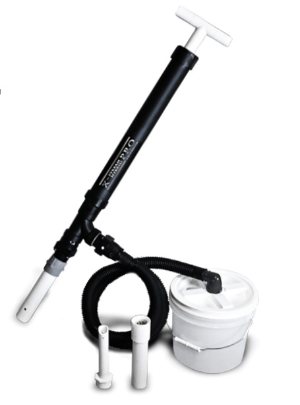Monday, July 20 2015
As you read this, water levels in many Western states will be at their lowest of Gold sniping, also called crevicing or cracking, is basically cleaning out cracks and crevices in and around bedrock— areas that were submerged for many, many years but are accessible during times of drought. These areas have the potential to trap and retain gold. After visually determining the best places to snipe (more on that later), all you need are a few simple tools for collecting and panning the high-grade material from those cracks. Basic, yet effective! When normally rushing rivers and streams are reduced to a trickle and boulders and bedrock are exposed, you won’t need a wet suit or snorkel, only some waders. The boulders can still be very slippery, though, so keep that in mind when crossing waterways. Most snipers do use a mask and snorkel and wetsuit. In addition, the basic tools for sniping include a plastic gold pan, long stainless steel tweezers, snuffer bottle, plastic vials, pry bars to loosen jammed-together rocks, a garden trowel or similar tool to dig behind boulders, and a bucket. A hand dredge or nugget sucker can really come in handy, too. The first step in prospecting, of course, is to stop by the appropriate BLM or Forest Service office to determine where you can recreationally hunt for gold. You don’t want to accidentally trespass on someone else’s claim. Once you’re there, visually study the river and think about all the areas that gold might be hiding. Loose flakes or nuggets of placer gold are much heavier than the surrounding sand and gravel, therefore, the dense metal gradually works its way downward and collects in seams in the bedrock. The inside bends of rivers tend to be good collection spots because the water slows there, allowing the heavier sands and metals to collect in and around anything that obstructs its path. Try investigating the exposed underwater root systems of any trees found along the bank, too. These act as natural gold traps. Large boulders offer opportunities as well. It's best to snipe on the downstream side of these monoliths since the back eddies occurring there sometimes pull gold and other heavy materials out of the passing current and force them to settle.
When you need a break from getting your feet wet (or the rest of you), panning along the bank or using a gold vacuum in the dry material along the shoreline can be lucrative. When the water level is low, plants, logs, and smaller rocks that used to be below the waterline are now visible. Gold might have collected around these obstructions when they were under water, but no one thinks to look here because they’re now in plain sight and almost too obvious. What others miss could be your bonanza! Bigger is not always better. With most mining operations, the more dirt you move, the more gold you get. As difficult as drought conditions are for farmers, ranchers, and many others, prospectors can use the low water levels to our advantage. Now is the time to work potential bedrock hot spots that could never be reached in normal years. Summer won’t last long, so get out there and get your share of the gold… sniping is just one more mining method that could have you yelling “Eureka!” |
|
Nugget of News Blog |






 If you’re sniping underwater, float on the water with your mask and snorkel, going downstream with the current. Look for crevices below the waterline that are reachable. When you locate a likely spot, remove the loose sand that commonly fills crevices in the bedrock. “Fan” away the sand and lighter debris with your hand, then use a pry bar or other
If you’re sniping underwater, float on the water with your mask and snorkel, going downstream with the current. Look for crevices below the waterline that are reachable. When you locate a likely spot, remove the loose sand that commonly fills crevices in the bedrock. “Fan” away the sand and lighter debris with your hand, then use a pry bar or other  Sniping is about the little things— working smaller areas very thoroughly. Perhaps the most pleasurable thing about sniping is its simplicity. You can hike in and get away from the crowds, and enjoy some peace and quiet and lovely scenery. It is a cool way to spend a hot summer day, and if you have patience and really learn to read the stream, you will find more and more gold using this method. If you’re new to gold sniping, you also might want to search YouTube for videos showing snipers in action.
Sniping is about the little things— working smaller areas very thoroughly. Perhaps the most pleasurable thing about sniping is its simplicity. You can hike in and get away from the crowds, and enjoy some peace and quiet and lovely scenery. It is a cool way to spend a hot summer day, and if you have patience and really learn to read the stream, you will find more and more gold using this method. If you’re new to gold sniping, you also might want to search YouTube for videos showing snipers in action.